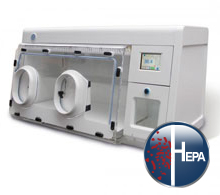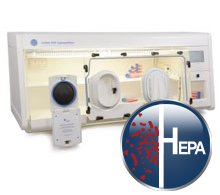The History of Hypoxia
The first observations regarding the role of hypoxia in tumour cells were noted at the beginning of the last century when Schwarz indirectly demonstrated that hypoxia increased tumour resistance to radiation therapy.
He noted that compression of skin to decrease blood flow reduced the effect of radiation on the cells. Further work by Crabtree and Cramer and later by Mottram demonstrated that lowering the oxygenation of tissues made them more resistant to damage caused by ionizing radiation. However, it was in the 1950s that Gray and Colleagues provided the first real evidence of a hypoxic microenvironment in human tumours and proposed that hypoxia had a role in the pathogenesis and progression of cancer. Since this pioneering work, the role of hypoxia in cancer has broadened significantly and is now appreciated to affect every major aspect of cancer biology.
...About the HypOxystation
With sensors continually monitoring the gas concentrations, it is very good at regulating and keeping the oxygen at a defined level. This key aspect is essential for our research. It also has built-in security and a USB port, which allows you to download data and monitor changes. These are important features designed to improve confidence in the reliability of results.
Dr Roger Phillips
University of Bradford’s Institute of Cancer Therapeutics
The low oxygen tumour environment is one of acidic pH, low nutrients and high catabolites, and contains cells with characteristics different to those of normal cells. Tumour hypoxia has shown to be a prognostic marker of disease progression, and can influence the outcome of chemotherapy and radiotherapy. Targeting hypoxic cells using conventional therapies has proved difficult. However, as this environment is one unique to solid tumours, it is a potential target for therapeutic intervention using drugs designed to act selectively on these cells. The latest research has focused on understanding the biology of hypoxic tumour areas and developing anti-cancer drugs that are effective in low oxygen environments.
When carrying out any type of cell research, scientists aim to recreate in the laboratory (in vitro) the same conditions as found in the body (in vivo). Precise measurement and control of oxygen tension are critically important in biological tumour models. Most hypoxia research is carried out at below 5% and typically between 0.2% and 0.5%. Technology that can provide accurate control and measurement of gas concentrations is essential in order to study tumour mechanisms and perform candidate drug testing under relevant and reproducible conditions.
The importance of replicating in vivo oxygen levels in vitro has also been proposed beyond cancer research. Currently most cell biology research is done in an environment with normal atmospheric oxygen levels of around 21%. The cells of our body are used to much less than this, usually in the range of 10% down to 0.5%. When cells are cultured they are usually kept in an incubator with 0.2% oxygen. However, when removed for manipulation they are exposed to atmospheric oxygen levels. Chandan and colleagues proposed that exposing cells to an unnaturally rich oxygen environment triggers cellular stress and significant physiological changes. In order to maintain truly representative physiological conditions, workstations offering tight control of gas levels, temperature and humidity are recommended for cell research.
Dr Roger Phillips, at the University of Bradford’s Institute of Cancer Therapeutics, researches tumour hypoxia and the biological and therapeutic aspects associated with it. Dr Phillips’ team use a specialised workstation (Hypoxystation, Don Whitley Scientific) to replicate the tumour environment. They carry out cellular assays to investigate the anti-cancer effects of different compounds over a closely controlled range of oxygen tensions. Specifically, they are researching drugs, which are designed to be activated under hypoxic conditions. These are pro-drugs – inactive compounds, which are metabolised to become cytotoxic.
Designed in conjunction with Dr Phillips himself, the modified atmosphere workstation can be used for cell biology research requiring normoxic, hypoxic and anoxic conditions. It offers precise control of oxygen and carbon dioxide as well as temperature and relative humidity. With a rapid response to user-selected conditions, oxygen can be controlled in 0.1% increments from 0.1% to 20% and carbon dioxide in 0.1% increments from 0.1% to 15%. By keeping tight control over conditions the workstation allows cells to be manipulated in situ without altering the incubation environment. The cells are therefore maintained under hypoxic conditions during drug exposure and afterwards, allowing longer-term effects to be observed.
Dr Phillips explained: “With sensors continually monitoring the gas concentrations, it is very good at regulating and keeping the oxygen at a defined level. This key aspect is essential for our research. It also has built-in security and a USB port, which allows you to download data and monitor changes. These are important features designed to improve confidence in the reliability of results.”
Research at the Bradford Institute has led to two drugs entering clinical trials, one of which is now in Phase II trials and one in Phase III. The focus of the team has now shifted back to pre-clinical research and the identification of new drug targets. They are also moving into a new field of research – autophagy, which is related to hypoxia and cell stress. A relatively new research field, autophagy is a process by which cells self-digest using their own enzymes and can lead to the ‘recycling’ of cellular components during oxidative stress.
Although it is now widely recognised that hypoxia has a major role in cancer progression and treatment failure, further work is required to define the precise role of hypoxia signalling in cancer and its prognosis. Close control over environmental conditions is essential to this research to allow flexibility in experimental design. The development of controlled atmospheric systems capable of accurately reproducing physiological conditions has played a key role in the development of anti-cancer therapeutics and increased understanding of the role of hypoxia in tumour biology. It is hoped that further research will lead to alternative and more effective therapeutic approaches in the future.
Control oxygen, carbon dioxide, humidity and temperature in a full featured touch screen interface.
The HypOxystation hypoxic incubator is available in four sizes to meet the needs of every researcher. The HypOxystation H35 hypoxia chamber comes standard with the transfer airlock and offers precise control by connecting to three different gas tanks. The user then specifies the gas mixture via a touch screen interface. The atmosphere is constantly monitored and adjusted by the real-time feedback system to ensure accuracy.
The H45 offers the same precise control as the H35, in a larger model with three entry ports. The H45 oxygen controlled chamber comes standard with the transfer airlock and removable front. The H45 has two sleeved ports and one rapid-entry port. The H85 has two sleeved ports, precise oxygen control and a larger transfer airlock than the H35 and H45.
H35 HypOxystation
The HypOxystation H35 provides researcher with precise control over the incubation environment. Gas levels, temperature and humidity can be set and easily adjusted using the touch screen interface. Transfer airlock allows for quick introduction of samples and equipment.

H35 HypOxystation HEPA
The H35 HEPA HypOxystation is a cell culture workstation ideal for those requiring HEPA filtration, as well as being able to accurately control oxygen, carbon dioxide, temperature and humidity.
